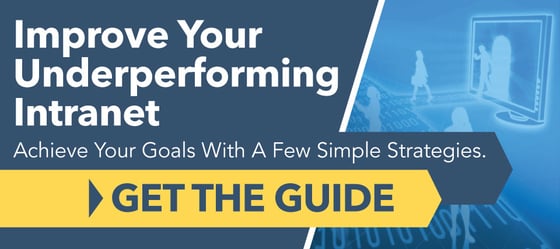It’s enough to drive someone to the brink of madness.
Your HR Director or Communications Manager posts an important notice on the corporate intranet, only to get inundated by messages from employees asking him or her to email it. If this a regular occurrence in your organization, chances are good the employees hate your intranet, and you probably do too. Colleagues avoid it because they can’t find what they need and find the content boring; managers are irritated by the wasted time and expense of deploying a platform no one wants to use.
The good news is that a few course corrections can drastically improve your intranet performance, and employee adoption along with it. The most common problems are usually traced to the planning process.
Lack Of Employee Input During Deployment
If the deployment was managed completely by IT, without input from users across all departments, chances are good your troubles started at jump street.
An intranet is not just a broadcast tool for managers. It should solve specific communication challenges experienced by employees, and that requires detailed input during the planning stage from people in various job roles. This is why we encourage clients to create three teams to guide the implementation:
Leadership Team – This group consists of one C-level executive who is responsible for the successful completion of the project, along with the CIO and other key divisional champions.
Technical Team – This team includes the CIO, intranet manager, and any other people charged with maintaining the IT infrastructure and networks within the organization.
Functional Team – Consisting of representatives from several departments, the functional team makes decisions, attends workshops, and completes assignments that will impact how their colleagues will interact with the portal.
Cramming Content On Pages
This is a natural consequence of building an intranet without setting measurable objectives. Companies that skip goal setting usually end up designing landing pages that have “something for everybody,” only to discover later on they are too hard to use effectively. In most cases, there’s just too much content for the user to sort through to make them useful.

It takes effort and planning to figure out what to exclude on your landing pages, but it is an absolute must if you want them to enhance the work your employees do. Simplicity leads to successful intranet design. Always.
Outdated Information Everywhere
How often would you return to a news site where the content is never updated? Yup, that’s what I thought.
The same goes for employees. If you want them to stay engaged with the portal, it needs to provide current and relevant information at all times. A dynamic intranet should feel like a living, breathing entity, always changing to conform to the needs of the users. This not only helps employee adoption – it can also help your organization avert disaster. If an urgent operational change doesn't get documented on the platform, an employee could make an error that jeopardizes your security, compliance, and reputation.
Poor Navigation And Document Management
Intranets are for creating and publishing content – and lots of it. Without a smart search strategy, you can easily find yourself back in the days of digging around a shared drive on your private server, looking for that one important document buried under heaps of junk files.
When will the madness end?
Creating an efficient navigation is one of the most critical, yet complex aspects of intranet design. With our Accelerated Intranet, we strive to make user navigation simple and intuitive, like shopping for an item on Amazon. For example, a document or asset easily categorized under “Finance" might also might have relevance in an “IT" library as well. By tagging the document with metadata, we can ensure the file is accessible from many different approaches, enabling fast, easy access for eligible users.
No Governance Plan
When it comes to intranet governance, the best defense is a good defense.
Without permissions and a hierarchy of responsibilities, your portal will lapse into chaos. In most cases, we prefer a collaborative governance committee comprised of people from different areas of the company, each representing the needs and desires of their colleagues. This committee will define the roles and permissions used by the entire staff. Governance helps the entire organization collaborate in harmony, rather than a discordant symphony of competing behaviors.
No Branding In The Design
We all want to believe that content is the only thing that matters, but the truth is presentation counts. If you want employees to feel at home on the intranet, it has to reflect the company culture, and that includes design and branding. You’d be surprised by how many intranets fail because they are uninteresting to look at. By keeping the emphasis on both content and design, you will find it easier to keep people engaged.
Hate is a strong word, but employees don’t mind using it when they are forced to use tools that make their jobs harder.
By introducing changes that help end-users with specific challenges they talk about in meetings, you will see a drastic change in attitude about your corporate portal. When an entire month goes by and no one asks you to email the report you posted on the hub – you’ll know you’re there.

